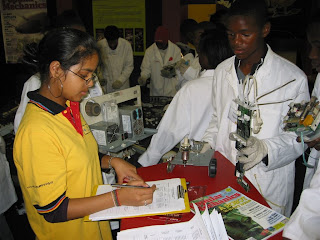
Come to Fish Hoek and go back thousands of years in time via Peer's Cave. This is a very cool way to celebrate African Origins Month in September.
The field trip is Saturday 8 September. Meet at 10 am at the cave, and spend the day on a guided tour.
Peer's Cave is famous for rock-climbing. Back before it was known as Peer's Cave, it was the anonymous spot where in 1926 to 1927, Victor Peers, his wife, and their son Bertie discovered many stone age tools and the remains of nine people from the Stone Age, one of whom became famous as 'Fish Hoek Man'.
The peerless Peers had long been interested in science, but their focus was more biology than archaeological. They discovered a mostly-blocked-up Peers' Cave in Fish Hoek and began excavating in May 1927 with the occasional help of Mrs Peers.
 Peers Cave is a low shelter, 38 feet deep, looking south-east towards nearby hills, wholly protected from the raging north-east winds. The shelter is under the buttresses of a small group of hills isolated from the main Kalk Bay range. They're immediately above and opposite the entrance to the Kalk Bay pier but the front of the shelter is shielded by rock and bush, making it less visible.
Peers Cave is a low shelter, 38 feet deep, looking south-east towards nearby hills, wholly protected from the raging north-east winds. The shelter is under the buttresses of a small group of hills isolated from the main Kalk Bay range. They're immediately above and opposite the entrance to the Kalk Bay pier but the front of the shelter is shielded by rock and bush, making it less visible.What did the Peers (father, mother and son) discover? Early on, two crude pounders were found embedded in deposits of sea shell after two feet of the floor was dug up.
Careful sifting of the shells found artistry: punched or bored shells, as you would use for beads and decoration.
Deeper, further in, a number of human toe and finger bones were discovered, and other fragments of an infant skeleton disturbed by the previous excavators.
Many other fascinating relics of the past were found, echoes from our long-gone ancestors: a few stone implements, some no larger than a fingernail. Fragments of woven reed. Mother-of-pearl ornaments. A piece of rope. Bone awls and arrow-points. Crude stones shaped to crack open stubborn shells. Stones bored to have a doughnut-shaped hole through their centre. Beads of ostrich egg-shell.
The residents of Peer's Cave, a prime piece of beachfront property, were clearly Strandlopers. Beachcombers.

Then the big discovery was made. Tucked away under the little shelters to the rear of the cave, three adult skeletons. Most had been buried face downwards, with the legs folded under the stomach, and the arms tucked under the chest. Their teeth were all good. A flat stone had been laid on the shoulders by the mourners. Ostrich egg beads strung on stripes of hide hung around their necks.
One had the decayed remnants of medicine bags strung as a curative belt about her. Auntie evidently suffered from lameness.
Under another of these skeletons a fragment of rusted European iron was found, proving that this last burial was actually made after the early Portuguese voyagers has passed this way.
More bones were found. The most dramatic find of all, however, was that of a little skull.
It was older than the others. Older by tens of thousands of years. It lay at a greater depth than any other skeleton, almost black with age. And its bone structure was different from the later inhabitants.
Mrs Peers probably was not familiar with the concept of 'hlonipha' - respect. But she knew what to do. She decided that this small, blackened relic of a prehistoric past could not possibly be transported home in anything as homely as a rucksack.
She removed her own hat and laid the skull gently inside.
The skull represented our evolutionary ancestors, early humans who inhabited South Africa 15 000 years ago.
To this day, faint traces of ochre-painted fingers and hands mark the rock wall. Handprints from our past.
* Booking is mandatory. Contact Carmen Solomons at carmen.solomons@mtnsciencentre.org.za or phone Carmen at 021 529 8100.
* African Origins Month is sponsored by the Deparment of Science and Technology, led by Minister Mosibudi Mangena and implemented by the Southern African Agency for Science and Technology Advancement, led by Beverley Damonse.




















